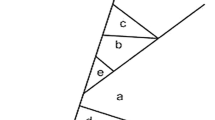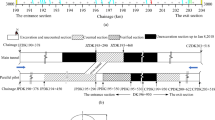Abstract
Large armourstone blocks are used to protect coastal construction against current and wave forces. Ideally such blocks should be durable and stay intact during engineering lifetime. The quality of these large blocks is, among other factors, influenced by the occurrence of internal disturbances, such as fissures. If the blocks fracture, spall or abrade during engineering lifetime a construction may be significantly weakened and finally failure may take place.
In this investigation attention is focussed on the prediction of spalling and fracturing of rock blocks due to pre-existing fissures. The quality of the blocks was assessed by measuring the velocity of acoustic waves propagating through the rock. The acoustic measurements were done with commercially available simple equipment. For an appreciation of the results of the velocity measurements, the blocks were dropped from a specified height in droptests. In the laboratory the effect of normal pressure on open discontinuities to the acoustic velocity was investigated.
The data obtained from the acoustic measurements were handled according to a simple method based on the cumulative distribution of normalized velocities. An important result of the investigation is the development of a general classification system for armourstone based on acoustic measurements: The “I-value” is obtained by the data handling method and gives information about the distribution of the acoustic velocities of a rock
I-value | Class | Description |
|---|---|---|
< 1.25 | I | good |
1.25-2.00 | II | moderate |
> 2.00 | III | bad |
block. A value of one means that no significant disturbances are present in the block tested.
Résumé
De gros enrochements sont utilisés pour protéger les constructions cotières contre les courants et les vagues. Ces blocs devraient demeurer intacts en principe pendant toute la vie des ouvrages. Leur qualité est en fait influencée, parmi d’autres facteurs, par la présence de discontinuités internes, telles que les fissures. Si les blocs se fracturent, se brisent ou s’usent, les ouvrages qu’ils protègent peuvent être vulnérables et on peut aller jusqu’à leur rupture.
La recherche présentée est focalisée sur la prédiction de l’écaillage et de la fracturation des blocs dues à des fissures préexistantes. Leur qualité est déterminée par la mesure de la vitesse de propagation des ondes sonores dans la roche. Les mesures ont été faites à l’aide d’un équipement simple disponible dans le commerce. Pour vérifier les résultats obtenus par la mesure des vitesses, les blocs ont été soumis à des essais de chute d’une hauteur déterminée. En laboratoire, l’effet de la pression sur des discontinuités ouvertes a été étudiée par rapport à la vitesse des ondes. Les résultats des mesures de vitesse obtenues ont été traités par une méthode simple fondée sur la distribution cumulée des vitesses normalisées. Le résultat le plus important de la recherche est le développement d’un système de classification pour les enrochements fondé sur la mesure des vitesses:
Valuer I | Classe | Description |
|---|---|---|
< 1.25 | I | bon |
1.25-2.00 | II | moyen |
> 2.00 | III | mauvalis |
La valeur I est obtenue à l’aide de la méthode mise au point et elle donne des informations sur la distribution des vitesses dans un bloc rocheux. La valeur 1 signifie qu’aucune discontinuité significative n’affecte le bloc étudié.
Similar content being viewed by others
References
ALLSOP N.W.H., BRADBURY A.P., POOLE A.B., DIBB T.E., HUGHES D.W., 1985: Rock durability in the marine environment. Hydraulics Research Limited. Wallingford.
BONVALLET J., BOTH J., PERAGALLO J., PILET PH. and WOJTKOWIAK, F. (1983): Stabilité des carrières sousterraines: méthodes d’ausculation dynamique. Bull. I.A.E.G., 26–27, 193–200.
DEARMAN W. R., TURK N., IRFAN Y., ROWSHANEI H. (1987): Detection of rock material variation by sonic velocity zoning. Bull. I.A.E.G., 35, 38.
EIJK F.C.A.A. van, 1987: Quality designation for large rockblocks. (Internal publication: Section of Engineering Geology. Faculty of Mining and Petroleum Engineering. No. 42. Delft University of Technology).
LAMA R.D. and VUTUKURI V.S., 1978: Handbook on mechanicalproperties of rocks. Testing techniques and results, vol. 2. Trans Tech. Publications. Germany.
LEONORA R., 1985: The influence of anisotropy on the unconfined compressive strength of rocks. (Internal publication: Section of Engineering Geology. Faculty of Mining and Petroleum Engineering. No. 56. Delft University of Technology).
NEW B.M. and WEST G., 1980: The transmission of compressional waves in jointed rock. Eng. Geol., vol. 15, 151–161.
NIESE, M. S.J., 1988: Classification of large armourstone using an acoustic velocity analysis method. (Internal publication: Section of Engineering Geology. Faculty of Mining and Petroleum Engineering. No. 65. Delft University of Technology).
POOLE A.B., FOOKES P.G., DIBB T.E., HUGHES D.W. (1983): Durability of rock in breakwaters. In: “Breakwaters design and construction”, Thomas Telford Ltd., London, 19–30.
WESTEN J.M. van SCHIPPERS C.W., LAAN G.J. and LIEVESTRO R., 1987: Evaluatie van de kwaliteitszorg voor de breuksteen voor de stormvloedkering Oosterschelde. (Internal publication: Rijkswaterstaat. Dienst Weg-en Waterbouwkunde. DWW-rapport, no.MAA-R-86074/ WBS-N-86350. Burghsluis. The Netherlands).
Author information
Authors and Affiliations
Rights and permissions
About this article
Cite this article
Niese, M.S.J., Van Eijk, F.C.A.A., Laan, G.J. et al. Quality assessment of large armourstone using an acoustic velocity analysis method. Bulletin of the International Association of Engineering Geology 42, 55–65 (1990). https://doi.org/10.1007/BF02592620
Published:
Issue Date:
DOI: https://doi.org/10.1007/BF02592620




